On United Nations Policy and Practice
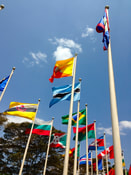
My work with the United Nations both as a staff member (2004-7), and a consultant with a range of departments, funds and agencies (since then), has largely focused on deepening understanding about conflict and how to prevent it on the one hand, and how to build sustainable peace rooted in inclusive development and resilient societies, on the other. My work usually involves research and evaluation aimed at developing more robust evidence bases, and clearer conceptual and theoretical linkages, to underpin and strengthen policy, strategy and programming.
The publications that follow are divided into two parts: UN reports; Scholarly publications about the United Nations.
The publications that follow are divided into two parts: UN reports; Scholarly publications about the United Nations.
UN Reports
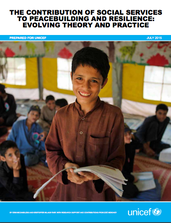
The Contribution of Social Services to Peacebuilding and Resilience: Evolving Theory and Practice
Erin McCandless and Kristoffer Nilaus-Tarp, with research and contributions by Zoë Meroney
Prepared for UNICEF, July 2015
Report - open access
Conflict and fragility present a grave threat to UNICEF’s objective of improving the lives of children and their caregivers around the world. Resilience has emerged through a variety of disciplines as an attempt to depart from a path where vulnerable communities and societies require assistance in recurrent crises because the underlying causes are not addressed. This report focuses on how the management and delivery of social services – such as education, health, clean water and protection – can achieve peacebuilding results, and in so doing, ultimately build the resilience of individuals, communities and societies to conflict.
Erin McCandless and Kristoffer Nilaus-Tarp, with research and contributions by Zoë Meroney
Prepared for UNICEF, July 2015
Report - open access
Conflict and fragility present a grave threat to UNICEF’s objective of improving the lives of children and their caregivers around the world. Resilience has emerged through a variety of disciplines as an attempt to depart from a path where vulnerable communities and societies require assistance in recurrent crises because the underlying causes are not addressed. This report focuses on how the management and delivery of social services – such as education, health, clean water and protection – can achieve peacebuilding results, and in so doing, ultimately build the resilience of individuals, communities and societies to conflict.
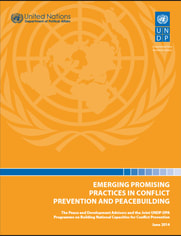
Emerging Promising Practices in Conflict Prevention and Peacebuilding
Peacebuilding and Development Advisors and the Joint UNDP-DPA Programme on Building National Capacities for Conflict Prevention. June 2014
This report focuses on the catalyzed efforts across the UN system regarding the urgency of preventing conflict in fragile and conflict-affected settings. Among a wide range of experts and advisors that work across UNDP Country Offices, specifically on crisis prevention and recovery, have emerged a senior staff with specialized skills, knowledge and expertise known as the Peace and Development Advisors (PDAs). The three main areas of engagement of the PDAs are: political and conflict analysis, conflict prevention strategy and programming, and catalyzing and facilitating conflict prevention and peacebuilding initiatives. PDAs also focus on dialogue and mediation support, reconciliation and social cohesion, and building infrastructures for peace. Regardless of the specific activities PDAs engage with, PDA efforts are designed to build national capacities to build peace and prevent conflict.
Peacebuilding and Development Advisors and the Joint UNDP-DPA Programme on Building National Capacities for Conflict Prevention. June 2014
This report focuses on the catalyzed efforts across the UN system regarding the urgency of preventing conflict in fragile and conflict-affected settings. Among a wide range of experts and advisors that work across UNDP Country Offices, specifically on crisis prevention and recovery, have emerged a senior staff with specialized skills, knowledge and expertise known as the Peace and Development Advisors (PDAs). The three main areas of engagement of the PDAs are: political and conflict analysis, conflict prevention strategy and programming, and catalyzing and facilitating conflict prevention and peacebuilding initiatives. PDAs also focus on dialogue and mediation support, reconciliation and social cohesion, and building infrastructures for peace. Regardless of the specific activities PDAs engage with, PDA efforts are designed to build national capacities to build peace and prevent conflict.
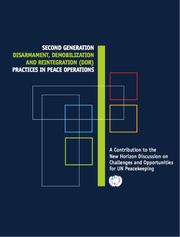
Second Generation DDR Practices in UN Peace Operations:
A Contribution to the New Horizon Agenda
Office of Rule of Law and Security Institutions (OROLSI), Department of Peacekeeping Operations (DPKO), 2009.
Report - open access
This report makes the case for less reliance on "traditional' DDR processes, that focus on combatants within military structures, and greater adoption of "Second Generation" approaches that better respond to the complex settings confronting United Nations peace operations. Second Generation activities can be implemented when the preconditions for traditional DDR are not in place, in order to support the peace process, build trust, contribute to a secure environment and help build the foundation for longer term peacebuilding. They are programmed locally using an evidence-based approach and focusing on the communities affected by violence. These efforts, reinforced by regular assessments, enable practitioners to more effectively adapt to new developments. As a contribution to the “New Horizon” process of engaging Member States in a policy dialogue on the challenges and opportunities of peacekeeping, this report aims to provide the tools needed to address the increasingly complex reality of DDR operations.
A Contribution to the New Horizon Agenda
Office of Rule of Law and Security Institutions (OROLSI), Department of Peacekeeping Operations (DPKO), 2009.
Report - open access
This report makes the case for less reliance on "traditional' DDR processes, that focus on combatants within military structures, and greater adoption of "Second Generation" approaches that better respond to the complex settings confronting United Nations peace operations. Second Generation activities can be implemented when the preconditions for traditional DDR are not in place, in order to support the peace process, build trust, contribute to a secure environment and help build the foundation for longer term peacebuilding. They are programmed locally using an evidence-based approach and focusing on the communities affected by violence. These efforts, reinforced by regular assessments, enable practitioners to more effectively adapt to new developments. As a contribution to the “New Horizon” process of engaging Member States in a policy dialogue on the challenges and opportunities of peacekeeping, this report aims to provide the tools needed to address the increasingly complex reality of DDR operations.
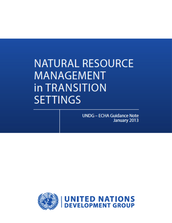
Natural Resource Management in Post-Conflict Transitional Settings
David Jensen and Matti Lehtonen, United Nations Development Group, 2013
Report - open access
This guidance note aims to help UNCTs and UN Missions understand the negative and positive roles that natural resources can play in peace consolidation. It provides practical guidance to assist in thinking through how natural resource management principles and practices can feed into transitional analysis and planning frameworks including: Post Conflict Needs Assessment (PCNA), Integrated Mission Planning Process (IMPP), Peacebuilding Frameworks and Tools, the UN Common Country Analysis (CCA) and the UN Development Assistance Framework (UNDAF). While not relevant in every setting, the guidance offers diagnostic tools to assist those on the ground in deciding where and when such issues need to be addressed, how this can be done, what types of roles the UN can take on, and how the UN can support other actors. McCandless: contributor and editor.
David Jensen and Matti Lehtonen, United Nations Development Group, 2013
Report - open access
This guidance note aims to help UNCTs and UN Missions understand the negative and positive roles that natural resources can play in peace consolidation. It provides practical guidance to assist in thinking through how natural resource management principles and practices can feed into transitional analysis and planning frameworks including: Post Conflict Needs Assessment (PCNA), Integrated Mission Planning Process (IMPP), Peacebuilding Frameworks and Tools, the UN Common Country Analysis (CCA) and the UN Development Assistance Framework (UNDAF). While not relevant in every setting, the guidance offers diagnostic tools to assist those on the ground in deciding where and when such issues need to be addressed, how this can be done, what types of roles the UN can take on, and how the UN can support other actors. McCandless: contributor and editor.
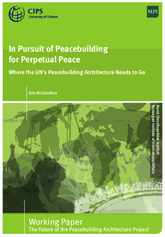
In Pursuit of Sustainable Peacebuilding:
Where the UN’s Peacebuilding Architecture Needs to Go
Center for International Policy Studies, University of Ottawa, the Norwegian Institute of International Affairs, 2010. Report - open access
This paper suggests that the new focus on the immediate aftermath of conflict supported by the UN’s Peacebuilding Architecture (PBA) crowds out important debates surrounding potential core drivers or building blocks of sustainable peace. Strengthened efforts are needed to conceptually and practically link this ‘early recovery’ period with longer-term peace. To respond to new and changing contexts and live up to its mandate to support peace sustainability, the PBA will need a robust strategy and structure that allows it the dynamism and flexibility needed to be responsive and effective, learning and incorporating lessons along the way. The paper examines five core drivers of peace sustainability, briefly assesses the PBA and its vision as laid out in the new SG’s report on ‘Peacebuilding in the Immediate Aftermath of Conflict’, before discussing six key areas that fall under the two streams of knowledge development and management and coordination, advising and capacity development aimed at strengthening the PBA’s potential.
Where the UN’s Peacebuilding Architecture Needs to Go
Center for International Policy Studies, University of Ottawa, the Norwegian Institute of International Affairs, 2010. Report - open access
This paper suggests that the new focus on the immediate aftermath of conflict supported by the UN’s Peacebuilding Architecture (PBA) crowds out important debates surrounding potential core drivers or building blocks of sustainable peace. Strengthened efforts are needed to conceptually and practically link this ‘early recovery’ period with longer-term peace. To respond to new and changing contexts and live up to its mandate to support peace sustainability, the PBA will need a robust strategy and structure that allows it the dynamism and flexibility needed to be responsive and effective, learning and incorporating lessons along the way. The paper examines five core drivers of peace sustainability, briefly assesses the PBA and its vision as laid out in the new SG’s report on ‘Peacebuilding in the Immediate Aftermath of Conflict’, before discussing six key areas that fall under the two streams of knowledge development and management and coordination, advising and capacity development aimed at strengthening the PBA’s potential.
Scholarly and policy orientated publications about the UN
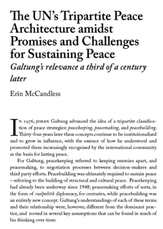
The UN’s Tripartite Peace Architecture amidst Promises and Challenges for Sustaining Peace: Galtung’s Relevance a Third of a Century Later
In Experiments with Peace, UK: Fahamu Books. 2010.
Chapter
In 1976, Johan Galtung advanced the idea of a tripartite classification of peace strategies: peacekeeping, peacemaking, and peacebuilding.This short tribute considers how Galtung's understanding of these three concepts is promisingly but unevenly reflected in the United Nations strategies and activities. The paper suggests that Galtung's profound and still pervasive influence is growing and affects the theory and practice of peacebuilding in important ways.
In Experiments with Peace, UK: Fahamu Books. 2010.
Chapter
In 1976, Johan Galtung advanced the idea of a tripartite classification of peace strategies: peacekeeping, peacemaking, and peacebuilding.This short tribute considers how Galtung's understanding of these three concepts is promisingly but unevenly reflected in the United Nations strategies and activities. The paper suggests that Galtung's profound and still pervasive influence is growing and affects the theory and practice of peacebuilding in important ways.
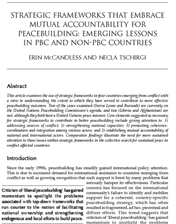
Strategic Policy Frameworks and Peacebuilding in United Nations Peacebuilding Commission (PBC) and Non-PBC countries: A Comparative Analysis
Co-authored with Neclâ Tschirgi, JPD, 5:2, 2010.
Article
This article examines the use of strategic frameworks in four countries emerging from conflict with a view to understanding the extent to which they have served to contribute to more effective peacebuilding outcomes. Core elements suggested as necessary for strategic frameworks to contribute to better peacebuilding include giving attention to: 1) addressing sources of conflict; 2) strengthening national capacities; 3) promoting coherence, coordination and integration among various actors; and 3) establishing mutual accountability of national and international actors. Comparative findings illustrate the need for more sustained attention to these issues within strategic frameworks in the collective search for sustained peace in conflict-affected countries.
Co-authored with Neclâ Tschirgi, JPD, 5:2, 2010.
Article
This article examines the use of strategic frameworks in four countries emerging from conflict with a view to understanding the extent to which they have served to contribute to more effective peacebuilding outcomes. Core elements suggested as necessary for strategic frameworks to contribute to better peacebuilding include giving attention to: 1) addressing sources of conflict; 2) strengthening national capacities; 3) promoting coherence, coordination and integration among various actors; and 3) establishing mutual accountability of national and international actors. Comparative findings illustrate the need for more sustained attention to these issues within strategic frameworks in the collective search for sustained peace in conflict-affected countries.
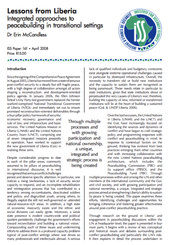
Integrated Approaches to Peacebuilding in Transitional Settings: Lessons from Liberia
ISS Paper, South Africa: Institute for Security Studies, 2008
Paper - open access
This paper examines early efforts by the United Nations in Liberia (UNMIL and the UNCT) and the Government of Liberia in post-conflict Liberia (focused on years 2006-7), to identify the sources and dynamics of conflict to craft strategic policy and programming responses with conflict and peacebuilding in mind. The paper argues that through multiple processes within and among the UN and other members of the international community and the GoL and civil society, and with growing participation and national ownership, a unique, integrated and strategic process aimed at strengthening Liberia’s ability to sustain its peace is being created. Challenges and opportunities for bringing coherence and fostering greater effectiveness around post-conflict peacebuilding practice are also examined.
ISS Paper, South Africa: Institute for Security Studies, 2008
Paper - open access
This paper examines early efforts by the United Nations in Liberia (UNMIL and the UNCT) and the Government of Liberia in post-conflict Liberia (focused on years 2006-7), to identify the sources and dynamics of conflict to craft strategic policy and programming responses with conflict and peacebuilding in mind. The paper argues that through multiple processes within and among the UN and other members of the international community and the GoL and civil society, and with growing participation and national ownership, a unique, integrated and strategic process aimed at strengthening Liberia’s ability to sustain its peace is being created. Challenges and opportunities for bringing coherence and fostering greater effectiveness around post-conflict peacebuilding practice are also examined.
Editorials on UN policy and practices
Peace operations and development interventions: Expanding the focus on context, politics, participation and transparency
McCandless, E. & Abu-Nimer, M. (2009). JPD, 5(1), 1-7.
Editorial-open access
McCandless, E. & Abu-Nimer, M. (2009). JPD, 5(1), 1-7.
Editorial-open access
